The discovery of DNA, RNA, and a molecular basis for inheritance involves the ongoing history of genetics from
1849 – 2014
Always the appearances were deceiving. |
||
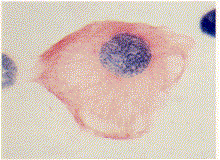 |
 |
|
| Frog's eggs. | Mitosis | RNA |
| The frog emerges from visible stages of amphibian transformation and there is also a step-by-step process that is invisible to the eye. Hidden from view, the nitrogen base pairs of nucleic acids to the chromosomes that enable frogs and all living things to survive this intricate, yet inherited process. | ||
"Not that long ago, biology was considered by many to be a simple science, a pursuit of expedition, observation and experimentation. At the dawn of the twentieth century, while Albert Einstein and Max Planck were writing mathematical equations that distilled the fundamental physics of the Universe, a biologist was winning the Nobel prize for describing how to make dogs drool on command."
|
||
"Few predicted, for example, that sequencing the genome would undermine the primacy of genes by unveiling whole new classes of elements — sequences that make RNA or have a regulatory role without coding for proteins. Non-coding DNA is crucial to biology, yet knowing that it is there hasn't made it any easier to understand what it does.
says Mel Greaves, a cell biologist at the Institute of Cancer Research in Sutton, UK. Instead, as sequencing and other new technologies spew forth data, the complexity of biology has seemed to grow by orders of magnitude." |
||
"The Human Genome at Ten," 2010 Nature. Published online 31 March 2010 | Nature 464, 664-667 (2010) |
||
Ideas | people | discovery | preconditions | molecule | dates | Zeitgeist | techniques | Mendelism | revival | eugenics | pangenes | nucleic acid work | structural research | protein complexity | X-rays | DNA | findings | chromosomes | nitrogen bases | findings | feedback | human genome project | basic dualism | order | new worldview | genetic engineering | summarized
"The origin of life was the origin of true heredity; we might even say the origin of life was the first gene. . . . By the first gene I mean replicator. A replicator is an entity, for example a molecule, that forms lineages of copies of itself. There will always be errors in copying, so the population will acquire variety."
Richard Dawkins, The Ancestor's Tale, (2004). p. 563.
British geneticist Charles Waddington wrote that, "It is the order of nucleotides along the double spiral which we have to think of as determining the character of the hereditary material at that region [of the chromosome]." (1962)
In October of 1977, Sir Peter Medawar, a famous biologist wrote that "the greatest scientific discovery of the twentieth century" is "without qualification," the explanation of "the chemical makeup of the compound deoxyribonucleic acid (DNA)."
Some complicated details of inheritance are reveled by:
The genes that are not in the nuclei
The discovery that revealed a hidden layer of existence.
James D. Watson, a codiscoverer of the nucleic acid code, had himself written, in 1980, that the "double helix . . . would revolutionize biology."
Rosalind Franklin, Maurice Wilkins, Francis Crick and James Watson competed with Linus Pauling in a race to discover how proteins were built from DNA and how the structure of the nucleic acids or DNA assists in the creation of amino acids that code for specific proteins. Each of these participating units: DNA, amino acids, and proteins are together, all involved in the hereditary processes of living organisms. The study of heredity from a biological perspective has been called genetics for just over a century, since 1900.
Genes are not quite as precise as the word may imply.
Ideas | people | discovery | preconditions | molecule | dates | Zeitgeist | techniques | Mendelism | revival | eugenics | pangenes | nucleic acid work | structural research | protein complexity | X-rays | DNA | findings | chromosomes | nitrogen bases | findings | feedback | human genome project | basic dualism | order | new worldview | genetic engineering | summarized
The preconditions for development of progress in genetics occurred in four formative stages in the transformation of knowledge:
experimental, discovery, developmental, application
Early
years rediscovery of Mendel's forgotten laws of inheritance
| Cellular biology, fruit flies, corn & chromosomes
| Eugenics
Nucleic acid research | Chemistry,
X-ray crystallography, molecules | Complexity of the
genome | DNA - RNA double helix | Dates
The molecular configuration of nitrogen bases that comprise nucleic acids such as DNA & RNA are the "replicators" needed for life.
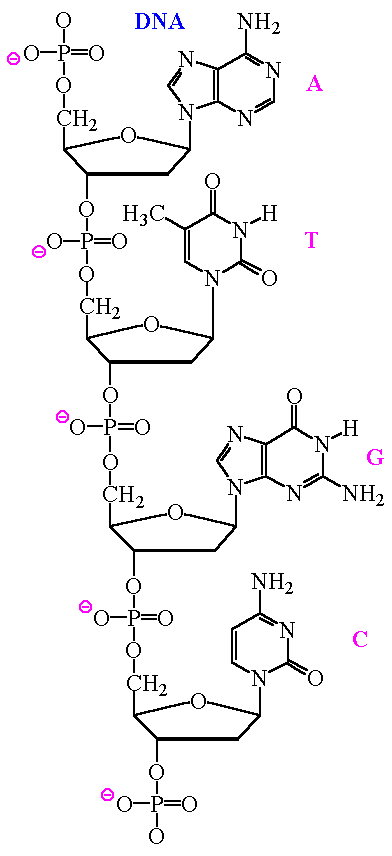
Another means to portray configuration of nitrogen bases in relation to the five carbon sugars and phosphate linkages.
Ideas | people | discovery | preconditions | molecule | dates | Zeitgeist | techniques | Mendelism | revival | eugenics | pangenes | nucleic acid work | structural research | protein complexity | X-rays | DNA | findings | chromosomes | nitrogen bases | findings | feedback | human genome project | basic dualism | order | new worldview | genetic engineering | summarized
1859, Darwin's On the Origin of Species published without his awareness of Mendel
1866, Gregor J. Mendel, published "laws of heredity," in peas
1868, Darwin's Variation of Animals & Plants under Domestication
1869, Dimitri Mendeleyev proposed the periodic law & table of elements
1869, Sir Francis Galton published Hereditary Genius
1882, Koch isolates the bacteria that causes tubercle bacillus, Tuberculosis1900, Hugo de Vries, rediscovers the importance of Mendel's work
1901, Amino acid tryptophan was discovered by Sir F. Hopkins
1909, Wilhelm Johannsen, coins "gene; genotype & phenotype"
1929, Kathleen Lonsdale uses x-rays to examine benzene molecules1930, Arne Tiselius developed electrophoresis for protein research
1934, Dorothy Hodgkin took the first x-ray diffraction photograph
1935, first commercial electron microscope built in England
1944, Erwin Schrödinger's published What is Life?1948, Dorothy Hodgkin uses x-ray crystallography to investigate protein structure.
1951, The immediate discovery stage commenced with discovery of the alpha-helix structure of proteins.
1953, DNA's structure determined after a race of four researchers to beat Linus Pauling to the answer: Francis Crick, James Watson, Maurice Wilkins, and Rosalind Franklin.
1961, Alexander Rich a biophysicist at MIT accurately shows that "that two single-strand ribonucleic acid (RNA) molecules could spontaneously align themselves to form a double helix," as a necessarily crucial partner in the processes of inheritance and metabolism.
1967, Charles Yanofsky and coworkers reveal definitively that the sequence of nitrogen bases (codons along a chromosome) determines the sequence of amino acids in a protein.
experimental, discovery, developmental, application
Ideas | people | discovery | preconditions | molecule | dates | Zeitgeist | techniques | Mendelism | revival | eugenics | pangenes | nucleic acid work | structural research | protein complexity | X-rays | DNA | findings | chromosomes | nitrogen bases | findings | feedback | human genome project | basic dualism | order | new worldview | genetic engineering | summarized
Seminal discoveries of the 19th century
techniques, discovered ideas, heuristics, early research
Zeitgeist is the "spirit of the times" and was characterized by a belief in the evolution of life.
Bateson's work:Darwin's publications and "a democracy of descent"
Technology altered reality: revealed that there was unseen complexity at the microscopic level:
Microscopy advances, 1742-1840.
Electricity, 1820-1823-1845.
Spectroscopy, 1859-60, cesium & solar spectrum.
X-ray radiation, November 8, 1895 (Wilhelm Konrad Roentgen)
Darwin studied breeding by artificial selection and the production of variation, but could not, as yet determine the units of hereditary processes.
Mendel and breeding variations in domesticated pea plants identified the outcomes of deliberate crossing of varied plants but could only speculate concerning the particulate material that was inherited by daughter generations from their ancestral line. His work was ultimately forgotten & but rediscovered.
Muller with his agronomic chemistry research & Bateson rediscover Mendel's work.
Morgan and the study of chromosomes in fruit flies.
Periodic Table of the elements
radiation as unseen exposure to electromagnetic fields
x-rays – are extremely high energy electromagnetic radiation and they expose the underlying structure of the calcium containing bones of the body.
ultra-violet rays – are high energy electromagnetic radiation beyond the visible range.
Ideas | people | discovery | preconditions | molecule | dates | Zeitgeist | techniques | Mendelism | revival | eugenics | pangenes | nucleic acid work | structural research | protein complexity | X-rays | DNA | findings | chromosomes | nitrogen bases | findings | feedback | human genome project | basic dualism | order | new worldview | genetic engineering | summarized
Classic period: Early years
Rediscovery of Mendel's suppressed work by Hugo de Vries, advocate of mutation theory of speciation.
Mendel's forgotten laws of inheritance
A string of beads were the homiletic imagery (like rosary beads) that Mendel figured were the material "germs," or seeds within seeds" that made up the inheritable materiality because the word "genes" did not exist.
beads or knots
codon–a section of nucleic acid that makes a protein unknown to Mendel.
measures locus; that is where & what shifts
Over time traits survive from one generation to the next that assist organisms in acquiring and digesting food, shelter, nesting sites, security & reproductive success; ... after artificial selection of breeders, Darwin and Wallace called this natural selection.
chemistry & physiology combine to yield basic information
chromosomes -- dark staining bodies in the nucleus -- fruit flies
physiology & cellular biology was not well understood
Morgan's work with fruit flies, corn and
Barbara McKlintock's work with "jumping genes" were a focus of research due to their relative ease of study.
Ideas | people | discovery | preconditions | molecule | dates | Zeitgeist | techniques | Mendelism | revival | eugenics | pangenes | nucleic acid work | structural research | protein complexity | X-rays | DNA | findings | chromosomes | nitrogen bases | findings | feedback | human genome project | basic dualism | order | new worldview | genetic engineering | summarized
Eugenics was a social program in the late nineteenth and early twentieth century to remove diseases and disabilities from the reproductive population. Problems arose when certain traits associated with isolated ethnic groups were used to sterilize emotionally disturbed and mentally disabled people. Some who favored eugenics did so because they were racially biased against minority ethnic groups such as Africans and Armenians. The racist strain of ethnic prejudice, soon led to eugenics policies and practices directed by Europeans against Asians, Africans an native Americans.
Social Darwinism, ethnocentrism, & public health in some sense converged to substantiate xenophobia and fear of ethnic minorities or ethnic majorities in Africa and Asia where European colonies were threatened by insurrection and rebellion.Belief in the perfectibility of human inheritance by eliminating mutant genes and those who possess genetic defects was often used as a cover for more sinister motives including, but not limited to:
legal sterilization of mentally ill (allegedly mental defectives),
identification of allegedly inferior traits,
imprisonment, sequestration and sterilization of insane persons and less powerful ethnic groups called "inferior races."
Genes are located along Chromosomes
gene - set of base pair sequences of DNA that serve to instruct, possessing a particular locus on a long chromosome within the nucleus of eukaryotic cells:
existing between the different cellular – nucleo and molecular levels or scales of material existence.
cellular:
organelles & nucleus; within the nucleus is (are)
chromosomal (stained body) information in code.
In the chromosomes are a paired bundle of inheritable traits
molecular: nucleotide = sugar, Phosphate & Nitrogen base
Ideas | people | discovery | preconditions | molecule | dates | Zeitgeist | techniques | Mendelism | revival | eugenics | pangenes | nucleic acid work | structural research | protein complexity | X-rays | DNA | findings | chromosomes | nitrogen bases | findings | feedback | human genome project | basic dualism | order | new worldview | genetic engineering | summarized
Modern period: Nucleic acid research
Chemistry, phage study (viruses), purines & pyrimidines are found in cell nuclei–later purines and pyrimidines are are molecules made of nitrogen base pairs.
Double helix -- DNA is comprised of a set of nitrogen bases (4); a sequence of three nitrogen base pairs are what code for an amino acid; held together by five carbon sugar and a phosphate group of molecules.
Discovery stage:
X-ray crystallography, was the means to discover the molecular structure of DNA
1948, Dorothy Hodgkin takes x-ray photos of Vitamin B-12 to determine its molecular structure
1952, Rosalind Franklin, produces an x-ray photograph of DNA that proves it has a double helical structure
1953, Watson & Crick using Franklin's & Wilkin's work est. the nitrogen base sequence or code of nucleic acids
1954, J.B.S. Haldane's book The Biochemistry of Genetics1990s Lewontin, Not In Our Genes, The Triple Helix
There are three related fields based on levels of complexity necessary to understand genetics.
1: X or Y chromosome:
Chromosomal regions where
loci of traits or diseases are found
sequences of DNA, nitrogen bases
A = T : adenine and thymine, base pairs
G = C : guanine and cytosine, base pairs
3: Molecular:protons bond to form specific atoms (C, O, N, P, S, K)
atoms bond to form molecules (depends on valences)
molecules can bond to form long chains {peptides}
long chained DNA molecules code for amino acids
series of specific amino acids code for proteins and these proteins are essential to all life!experimental, discovery, developmental, application
25 April 1953, Nature; Watson & Crick publish their model of DNA
1955, structure of the protein insulin is described; Severo Ochoa discovers that cellular energy is stored in phosphate bonds & that an enzyme produces RNA in the laboratory!Adenine and nitrogen base bonds with phosphate to carry energy and store energy on the microscopic, cellular or molecular level.
Over time traits survive that assist organisms in acquiring food, shelter, security & reproductive success... Darwin and Wallace called this natural selection. DNA & RNA are the genetic code found in 23 chromosomes.
The Double Helix, James D. Watson (Mentor, 1968), p. 143.
Findings
Relating time & the cosmos to life’s and human diversity
DNA & RNA are the ingredients in a complex genetic code. They are the basis –or particulate macromolecules– for the proteins, enzymes, hormones and recognizable traits. DNA is found in all 23 pairs of chromosomes (all the strands together comprise the human genome).The human genome is actually the equivalent of 6 billion pages of instructions for engendering a living human.
Fully one third (1/3) of the genome codes for parts of the central nervous system.
experimental, discovery, developmental, application
Chromosomes are long coiled strands of nucleic acids because they are found in the cell's nucleus; a walled in security sphere or bubble where inherited information on building proteins are stored as nucleic acids or DNA.
Upper left are chromosomes' images which are shown on lower right to be coiled around histones (a type of protein).
Nitrogen bases are found in all nucleic acids and were earliest identified in the nuclei of cells where chromosomes –dark staining bodies– were found from the investigation into variation based on fruit fly studies. Because fruit flies have large chromosomes that are easier to identify microscopically, these studies shaped early genetic research into nucleic acids.
Nucleic Acids are both DNA (in double helices) & RNA.
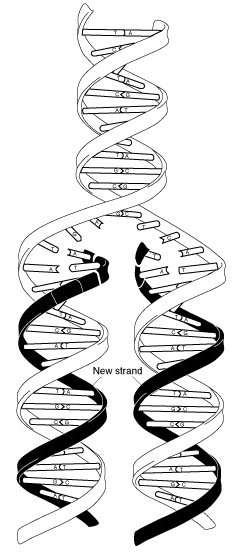
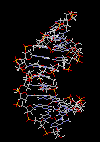
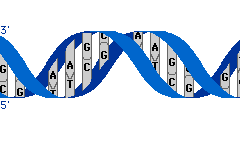
Double helix is the shape of the DNA
RNA is a single stranded polypeptide molecule {a really long strand!}
DNA is variable due to the sequential ordering of four nitrogen bases, A, T, C, G, (T is replaced by U in RNA).
Adenine, Guanine, Cytosine, & Thymine are bases in DNAAdenine, Guanine, Cytosine, & Uracil are bases in RNA
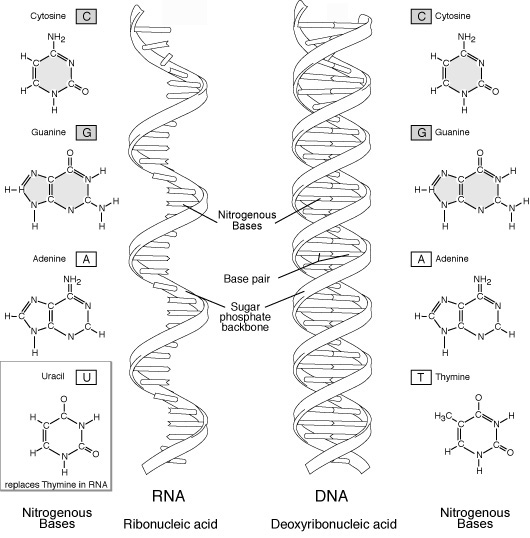

The "sleuths in the search"
The Double Helix, James D. Watson, (New York: Mentor, 1968), 29 Chapters, p. 143.
“how the structure of DNA was discovered” (ix)
experimental, discovery, developmental, application
Post-Modern
Application of the findings
The Human Genome Project
"The genome is is the entire set of genetic instructions in the nucleus of every cell. (In fact, each cell contains two genomes, one derived from each parent: the two copies of each chromosome we inherit furnish us with two copies of each gene, and therefore two copies of the genome.) Genome sizes vary from species to species. From measurements of the amount of DNA in a single cell, we have been able to estimate that the human genome –half the DNA contents of a single nucleus– contains some 3.1 billion base pairs: 3,100,000,000 As, Ts, As and Gs."
"in each, it is the DNA that oversees the extraordinary transformation from a relatively simple single cell to the stunningly complex adult of the species,comprised, in the human instance, of 100 trillion cells."
1988 cooperative venture of the National Institutes of Health and the Department of Energy to:
codify, describe, diagrammatically detail and examine the 4 billion genes of the 46 human chromosomes.
The human genome.
experimental, discovery, developmental, application
Feedback concept
Meade’s original definition in 1924: (Search for Solutions).
Han’s Selye’s descriptive (linguistic) description of the stress response syndrome
translation from verbal (linguistic) to visual (graphical).Freeman Dyson’s “global application” (Infinite in all Directions).
Garrett Hardin’s relation of feedback to ecology & human biology
(thermostat as templates a double translation of visual and verbal to graphical to model).Gregory Bateson’s “model” of ecological & human physical relations
(verbal translation to graphical representation that is both analytical & synthetic).
experimental, discovery, developmental, application
Basic ingredients
Phenotype-- the expression or external appearance of inherited traits: complexion, eye color, dentition, hair color, blood type, immune response, etc.
Genotype -- the underlying base pair sequences that together form the gene that codes for proteins, structures, hormones, enzymes, or neurotransmitters in the body of all living things.
In Eukaryotic organisms this genetic material is usually in the nuclei of cells, but the maternal line of inherited material can be traced in the mitochondrial DNA.
Adenine triphosphate [ATP]
Nitrogen base pairs make up the RNA and DNA polypeptide chains (long molecules).
DNA & RNA
Crucially significant and related molecules.
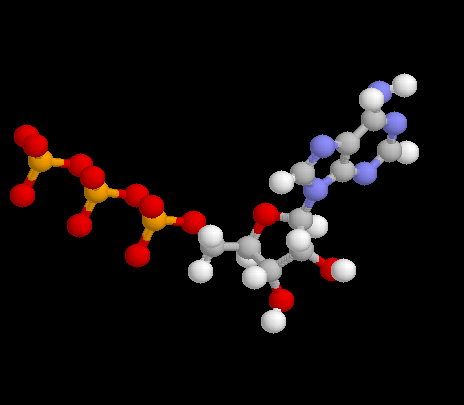
ATP, or adenosine triphosphate, shown above, is a molecule that stores energy for cellular metabolism.
Important biologically active molecules form proteins.
The structure of the hemoglobin protein –an active ingredient found in blood– reveals that numerous alpha-helices, or single strands of helical molecules are folded into a precise scaffold that allows the protein to embed a porphyrin ring in its interior. The shape of a protein allows it to function precisely as it does.
"Every protein is synthesized according to instructions contained in DNA."
(Starr, p. 162)
Ideas | people | discovery | preconditions | molecule | dates | Zeitgeist | techniques | Mendelism | revival | eugenics | pangenes | nucleic acid work | structural research | protein complexity | X-rays | DNA | findings | chromosomes | nitrogen bases | findings | feedback | human genome project | basic dualism | order | new worldview | genetic engineering | summarized
In retroviruses the instructional transfer is reversed and goes from RNA to DNA, instead of the other way around.
Types of molecules involved in replication:
DNA RNA
messenger, ribosomal, transfer
A
Adenine C
Cytosine G
Guanine T for Thymine
Uracil
"It takes three pairs to specify an amino acid."
Amino acids in long strings fold to make complex proteins that regulate bodily performance, function and development by making catalytic enzymes, markers or pheromones, and signals or hormones that direct responses of organs and organ systems throughout the body.
experimental, discovery, developmental, application
Ideas | people | discovery | preconditions | molecule | dates | Zeitgeist | techniques | Mendelism | revival | eugenics | pangenes | nucleic acid work | structural research | protein complexity | X-rays | DNA | findings | chromosomes | nitrogen bases | findings | feedback | human genome project | basic dualism | order | new worldview | genetic engineering | summarized
"junk" DNA
"Junk DNA got its name because the nucleotides there do not encode instructions for making proteins, the basis of life."
"…the vast material in organisms from bacteria to mammals consists of non coding DNA segments, which is interspersed with coding parts. In humans, about 97 percent of the genome is junk."
"junk DNA contains three to four times the redundancies of the coding segments."
("Talking Trash," Philip Yam, Scientific American; 3/95, p. 24)
Responses of genes to environmental disturbances:
radiation & mutation
Nitrogen base [Nb] pairs undergo numerous transcription
DNA transcript for amino acids --------> ----------> ----> produce a specified protein
A stretch DNA or RNA that specifies an exact amino acid sequence is called a codon.
Adenine -- Uracil, or A == U
Guanine -- Cytosine, or G == C > serine
Cytosine -- Guanine, or C == G
Genetic counseling for carriers of disease causing genes.
congenital sicknesses
disease [inheritable] gene loci Huntington's Chorea chromosome 4 Cystic fibrosis chromosome 7 Alzheimer's chromosome 19 Amyotrophic lateral sclerosis chromosome 9, 5, 17, 21 Colon cancer chromosome 2
experimental, discovery, developmental, application
Ideas | people | discovery | preconditions | molecule | dates | Zeitgeist | techniques | Mendelism | revival | eugenics | pangenes | nucleic acid work | structural research | protein complexity | X-rays | DNA | findings | chromosomes | nitrogen bases | findings | feedback | human genome project | basic dualism | order | new worldview | genetic engineering | summarized
Genetic engineering
Hormonal regulation controls growth and reproduction of creatures
progesterone -- genes that code for this protein ultimately influence the menstrual cycle and that cycle directly influences the reproductive potential.
estrogen -- receptors for this protein are found in both sexes but influence many female traits.
epinephrine -- is involved in fight or flight responses of creatures to stress, fear, and adaptation.
Ideas | people | discovery | preconditions | molecule | dates | Zeitgeist | techniques | Mendelism | revival | eugenics | pangenes | nucleic acid work | structural research | protein complexity | X-rays | DNA | findings | chromosomes | nitrogen bases | findings | feedback | human genome project | basic dualism | order | new worldview | genetic engineering | summarized
GMOs or Genetically Modified Organisms
Dr. Charles Sing, University of Michigan.
"What is a good gene and what is a bad gene depends on how you treat it." [genotype]
"Genes don't wake up [phenotype] until they are exposed to some environmental factor."
Dr. Richard Strummer, UC Berkeley
"the presence of a genetic marker . . . is no guarantee that abnormality or disease will show up."
[ 12/6/93, p.55, Newsweek ]
Geneto-phobia, fear of genetic engineering
Recombinant "genii loci" for micro-engineering or Frankenstein monster with a Faustian bargain?
Critic, Jeremy Rifkin; genetic engineering is unwise and too risky.
Defender, James Watson; gene therapies offer us a chance to retard crippling diseases.
Ideas | people | discovery | preconditions | molecule | dates | Zeitgeist | techniques | Mendelism | revival | eugenics | pangenes | nucleic acid work | structural research | protein complexity | X-rays | DNA | findings | chromosomes | nitrogen bases | findings | feedback | human genome project | basic dualism | order | new worldview | genetic engineering | summarized
Vocabulary
The vocabulary of modern inheritance is confusing and because it is so specialized includes three or more levels of material organization beyond our comprehension because we can not see to such depths of the organic structure we call nature.
new words old words genome Mendelian inheritance nucleic acids genetic material genes pangenes characteristics genes genetic traits chromosomes dark stained cellular bodies nucleotides heredity (in cells' nucleus) DNA or RNA alleles (pairs of material) nitrogen bases purines & pyrimidines P,O, H2O, N, C elements found in nucleic acids retrovirus virus "Genosystem" gene experimental, discovery, developmental, application
Ideas | people | discovery | preconditions | molecule | dates | Zeitgeist | techniques | Mendelism | revival | eugenics | pangenes | nucleic acid work | structural research | protein complexity | X-rays | DNA | findings | chromosomes | nitrogen bases | findings | feedback | human genome project | basic dualism | order | new worldview | genetic engineering | summarized
A dozen layers of complexity were revealed by scientific research from which life in the cosmos arises.
Up to the top of the stairway of order, because they can be very big.
Bottom of the stairway of order, because they are very, very small.
Ideas | people | discovery | preconditions | molecule | dates | Zeitgeist | techniques | Mendelism | revival | eugenics | pangenes | nucleic acid work | structural research | protein complexity | X-rays | DNA | findings | chromosomes | nitrogen bases | findings | feedback | human genome project | basic dualism | order | new worldview | genetic engineering | summarized
What exists at the bottom of material reality?
quarks, fermions, leptons, bosons
atomic neutrons, protons, electrons
of the 92 naturally occurring elements, these are most essential for life:
Carbon, Hydrogen, Oxygen, Phosphorus, Potassium, Iodine, Nitrogen, Sulphur, Calcium & Iron or the acronym for:
C H O P K I N S' Ca Fe or ( C. Hopkin's Cafe ).
TRANSCRIPTION
H2O (water) compound
bases adenine = thymine; guanine = cytosine
helix shape of DNA & RNA molecule
three bases code for an amino acid (21)
sequence of N bases = sequence of the amino acids
sequence of amino acids = protein, hormone, enzyme
sequences of DNA or RNA = traits on chromosomesThree base sequences code for amino acid, the building blocks of proteins.
Proteins, catalysts, hormones; the micro machinery of life.
The way proteins fold is critical to their proper functioning.Organelles, like mitochondria have their own DNA
Cells normally have DNA in the organelles and packed into the nucleus if these are Eukaryotic cells.
Up to the top of the stairway of organic order, eukaryotic cells when compared to prokaryotic cells can be very large because organelles are of a similar size to cells of typical prokaryote organisms.
experimental, discovery, developmental, application
Ideas | people | discovery | preconditions | molecule | dates | Zeitgeist | techniques | Mendelism | revival | eugenics | pangenes | nucleic acid work | structural research | protein complexity | X-rays | DNA | findings | chromosomes | nitrogen bases | findings | feedback | human genome project | basic dualism | order | new worldview | genetic engineering | summarized
Modern science’s worldview of evolutionary continuity as the descent from a common species.
There is an ongoing unfolding of organization as the universe ages, but hereditary change differs from physical changes over time.
Cosmos evolves ----> galaxies evolve
The stars evolve and supernova --- are ------> creating all 119 elements such as the nickel & iron that are Earth’s molten core.
The earth evolves –– plate tectonics ----------> creating Continents & Oceans.
Varied habitats evolve due to sedimentation & erosion.Biological creatures all have an hereditary lineage that may gradually adjust to abruptly changing habitats within a narrow range of opportunities.
Life by means of natural selection changes into divergent forms.
"Summa Geneologica" with apologies to Thomas Aquinas.
"The key to true heredity is that each replicator resembles the one from which it was copied more than it resembles a random member of the the population. The origin of the first such replicator, was not a probable event, but it only had to happen once. Thereafter, its consequences were automatically self-sustaining and they eventually gave rise, by Darwinian evolution, to all life."
Dawkins (2005), p. 563.
The molecules of carbon, phosphorus, nitrogen and sulphur are at the very foundation of what we now know as inheritance, or properly the science of inheritance that is a branch of biology called genetics.
Built over 170 years since Buffon and Lamarck noted the tendency of varieties of plants and animals to share common structural and functional anatomical features, the science of inheritance went through conceptual, experimental, rediscovery and redefining stages that led to remarkable realizations due to technology that was unavailable to the 18th century thinkers who proposed the inheritability of certain abilities from one generation to the next.
This is a story where appearances are deceiving because of the antiquity of the hereditary processes involved, the complexity of the relationships among chromosomes, enzymes, and proteins, not to mention a stifling role of persistently rigid beliefs that often overshadow to the extent that they ignore the findings of experimental research.
The stages in the creation of a new, complicated, and profoundly revolutionary understanding of inheritance were:
experimental, discovery, developmental, application
Keller | Triple Helix | Darwin | Margulis | Mayr | Triple Helix | Darwin | Margulis | Mayr | Lewontin |
What is wrong with the term genes?
Ideas | people | discovery | preconditions | molecule | dates | Zeitgeist | techniques | Mendelism | revival | eugenics | pangenes | nucleic acid work | structural research | protein complexity | X-rays | DNA | findings | chromosomes | nitrogen bases | findings | feedback | human genome project | basic dualism | order | new worldview | genetic engineering | summarized
About genes and genomesApplied genetics
Chromosome
Critics
dates & eventsdetails of the human genome
Development stage
developmental preconditions
Discovery stage
DNA & RNA relationsEugenics movement
Experimental stage
Formative period
FoundationsHistory of Genetics
Key developments
subject index
Vocabulary
Ideas | people | discovery | preconditions | molecule | dates | Zeitgeist | techniques | Mendelism | revival | eugenics | pangenes | nucleic acid work | structural research | protein complexity | X-rays | DNA | findings | chromosomes | nitrogen bases | findings | feedback | human genome project | basic dualism | order | new worldview | genetic engineering | summarized
"The Human Genome at Ten," 2010. Published online 31 March 2010 | Nature 464, 664-667.
Genetics Index | What makes genetics significant? | History of Genetics | DNA discovery | RNA | Resistance| Visual images
Diversity | Science subject index | Home page | Vocabulary | Genetics role
Genetics | Science Index | Population Index | Global Warming Index | Nature Index | Brief